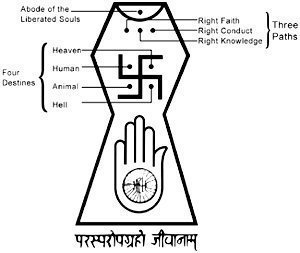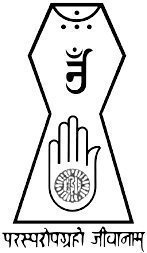|
|
Jain
Symbols
 |
 |
The comprehensive
Jain symbol consists of a crescent of the moon, three dots, the
Swastika or Om, the palm of a hand with the wheel (Chakra) inset,
and an outline figure encompassing all symbols. Each individual
symbol is also separately used in Jainism.
The three dots represent the Jain path of liberation (Jain trinity):
right faith (Samyak Darshan), right knowledge (Samyak Jnana) and
right conduct (Samyak Charitra), which together lead to liberation.
The crescent of the moon represents the region known as Moksha.
This region is at upper end of the three worlds and it is the
permanent place where the liberated souls reside.
The Swastika is a sacred symbol in Jainism. The four sides of
Swastika symbolize the four forms of the existence of worldly
(non-liberated) souls. The four forms are, heaven, human, tiryanch
(which includes animals, birds and plants) and hell. It reminds
us that worldly souls undergo a continuous cycle of birth, suffering
and death in these four forms. Hence one should follow the true
religion and be liberated from suffering.
The Sanskrit word Om is made up of five sounds and letters; a,
a, aa, u, and m:
The first letter "a" represents Arihant (human being
who has realized the true nature of reality and conquered the
worldly passions)
The second "a" represents Ashariry (Ashariry means without
physical body, liberated soul or Siddha or perfected being)
The third letters "aa" represent Acharya (Ascetic who
is the head of congregation)
The fourth letter "u" represents Upadhyay (Ascetic teacher)
The fifth letter "m" represents Muni (Sadhu or monks
who practices Jain principles).
Hence the Om represents the salutation to the five reverend personalities
in the Jain religion. Om is a short form of the Namokar Mantra.
The palm of the hand signifies the assurance; 'do not be afraid',
indicating that human beings, suffering due to karmic bondage
do not need to be disheartened.
The wheel of dharma (Chakra) with 24 spokes represents the religion
preached by the 24 Tirtliankaras consisting of nonviolence (Ahimsa),
compassion, Anekantvada and other virtues.
The outline figure looks like a person standing with their feet
apart and arms resting on both hips. This represents the Jain
description of the shape of the universe. The text underneath
the symbol. "Parasparopagraho Jivanam " translates as
"Living beings ( souls ) render services to one another".
The overall symbol depicts the belief that living being of all
the three worlds ( heaven, hell and earth ) suffer from the miseries
of transmigratory existence. They can follow the path of religion,
which is right faith, right knowledge and right conduct shown
by the Tirthankaras. This will bring auspiciousness to themselves,
minimize suffering to others and help them to obtain perfection,
after which they will live forever in the world of perfected beings.
Modern Jain thinkers create these symbols. But the original auspicious
Jain symbols are eight in numbers, which are as follows:
| Swastika |
|
| Shrivatsa |
|
| Pot |
|
| Seating |
|
| Nandyavarta |
|
| Sharavasamputa |
|
| Mirror |
|
| Couple of Pisces
|
|
These symbols are
originally drawn by Indrani, the queen of the Lord of the first
or second heaven with silver rice on the golden board in front
of Tirthankar at the end of the Snatra Abhisheka on the Mt. Meru
after the birth of Tirthankar.
"Shri Shankaracharya
has done injustice to this system (of Syadvada) by not understanding
it properly. Many learned scholars after him also subscribed to his
views. It is to be understood that the great Maharishi thought it
unnecessary to see the original works on this system (otherwise he
would not have misunderstood Jainism)."
-Professor Phanibhushana
Adhikari
(Banaras Hindu University)
Top
|


















